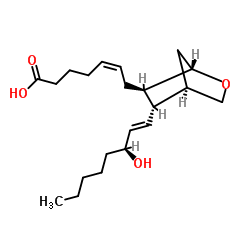Arachidonic acid epoxygenase and 12(S)-lipoxygenase: evidence of their concerted involvement in ductus arteriosus constriction to oxygen.
Barbara Baragatti, Flavio Coceani
文献索引:Can. J. Physiol. Pharmacol. 89(5) , 329-34, (2011)
全文:HTML全文
摘要
Oxygen promotes closure of the ductus arteriosus at birth. We have previously presented a scheme for oxygen action with a cytochrome P450 (CYP450) hemoprotein and endothelin-1 (ET-1) being, respectively, sensor and effector, and a hypothetical monooxygenase product serving as a coupling link. We have also found in the vessel arachidonic acid (AA) 12(S)-lipoxygenase (12-lipoxygenase) undergoing upregulation at birth. Here, we examined the feasibility of a sensor-to-effector messenger originating from AA monooxygenase and 12-lipoxygenase pathways. The epoxygenase inhibitor, N-methylsulfonyl-6-(2-)hexanamide, suppressed the tonic contraction of ductus to oxygen. A similar effect was obtained with 12-lipoxygenase inhibitors baicalein and PD 146176. By contrast, none of the inhibitors modified the endothelin-1 contraction. Furthermore, an AA ω-hydroxylation product, 20-hydroxyeicosatetraenoic acid (20-HETE), reportedly responsible for oxygen contraction in the systemic microvasculature, had no such effect on the ductus. We conclude that AA epoxygenase and 12-lipoxygenase jointly produce a hitherto uncharacterized compound acting as oxygen messenger in the ductus.
相关化合物
| 结构式 | 名称/CAS号 | 分子式 | 全部文献 |
|---|---|---|---|
 |
9,11-双脱氧-9Alpha,11Alpha-环氧基甲烷前列腺素F
CAS:56985-32-1 |
C21H34O4 |
|
Endothelin, PAF and thromboxane A2 in allergic pulmonary hyp...
2007-05-01 [Prostaglandins Leukot. Essent. Fatty Acids 76(5) , 299-308, (2007)] |
|
Glibenclamide inhibits agonist-induced vasoconstriction of p...
2006-01-01 [Placenta 27(6-7) , 660-8, (2006)] |
|
Substrate binding is the rate-limiting step in thromboxane s...
2001-05-04 [J. Biol. Chem. 276(18) , 14737-43, (2001)] |
|
On the regulation of tone in vasa vasorum.
1999-01-01 [Cardiovasc. Res. 41(1) , 237-45, (1999)] |
|
In vivo effects of a novel thromboxane A2/prostaglandin H2 (...
1995-02-01 [J. Pharmacol. Exp. Ther. 272(2) , 799-807, (1995)] |